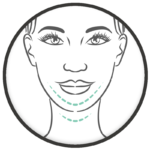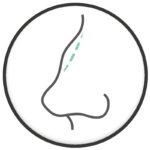
Read more...
Injectable fillers and fat injections can be used to replenish the lost volume and reduce the visibility of folds and shadows. Laser treatments or a chemical peel can be used to soften superficial spots and small wrinkles. For most people, however, a well-executed face or neck lift is considered the “gold standard” as it results in a predictable, natural and lasting outcome.
As we age, our skin gradually stretches due to a loss of elasticity, while the volume of fat and bone also decreases. This results in a net excess of skin around the jawline or in the neck. Fillers or fat have little to no effect on this excess skin. They can only solve the shapeless nature of the skin by filling it up from below, as it were. Over time, however, this often creates a larger facial shape with altered facial features.
The differences between the various surgical techniques are substantial and extremely important to our patients. The facial structure consists of a number of layers and the content of these layers varies in complexity. The skin layer, for example, is a relatively simple layer that is easily found. Virtually no blood vessels enter this layer, and the only nerves of significance are small sensory nerves. Most quick facelifts (mini lifts, c-lift, s-lift, macs-lift) are limited to this skin layer. The deeper layer is usually not or hardly opened, only pulled tight with a suture - the so-called “plication” technique. The deeper layer is much more complex than the skin layer, more difficult to find and more difficult to follow. In addition, there are important muscles, salivary gland tissue, larger blood vessels and nerves that are responsible for the movements of the mouth, eyelids and eyebrows on the deep side of this layer.
A beautiful, natural and sustainable result is not achieved by pulling on skin. The goal is to move the deeper layer of the face upwards in a vertical oblique direction. The skin follows automatically. It is important to perform this displacement with as little pulling force as possible. The more force used, the greater the likelihood that the result is unnatural and temporary. When the deeper layer is not or not entirely lifted, as with the aforementioned plication technique, by definition more tensile force will have to be used. A similar principle applies to the aging of the neck. Furthermore, the neck often has weak and sometimes hyperactive muscle tissue (platysma), excess fat under the neck muscles, a thickening of the deeper muscle layer (digastricus), and prolapse of the salivary glands. When the neck is aged, solely lifting the deeper layer is usually insufficient. When working under the chin, it is often necessary to work on fat and muscles to end up with a nice jawline.
This background information explains why a so-called “deep-plane” approach is presently seen as the most effective, natural and sustainable facelift technique. Nevertheless, it remains a complex procedure to perform. The art of deep-plane facelift surgery lies not so much in the technique itself, but in its execution. Extensive work must be done in close proximity to the facial nerve to sufficiently loosen the deep ligaments of the face. Finding the deep layer is not extremely complex in itself. However, following this layer until all deep ligaments are visible and can be detached while ensuring the safety of the facial nerve greatly increases the complexity. Hence, not every deep-plane facelift yields the same result. In this respect, the term does not say much. The surgeon’s experience determines to what extent the deeper layer can be followed; that is the deciding factor for the result, not the operational technique itself. To perform this technique adequately and safely, sufficient routine and dedication are therefore essential in addition to good training. For this reason, this procedure is mastered by only a limited number of surgeons. Dr. Wever often combines facelift surgery with fat augmentation, as this significantly improves the final result, especially in slim patients. The procedure takes around 3-4 hours and takes place under general anesthesia.
To undergo a facelift, it is essential to be healthy. If you smoke, you must quit at least four weeks in advance and continue to not smoke for at least four weeks after the surgery. We recommend taking at least two weeks off, although three weeks is usually better. A facelift is not a painful procedure. You will have a head wrap for 24 hours and drains for four days. Common complaints are a tight feeling around the neck, a bruised feeling when chewing, and a burning sensation behind the ears. Taking care of the scars around the ears is essential during the first week after surgery. Fortunately, significant complications are rare. We regularly see small hemorrhages under the skin. Due to their small size, however, it is often not necessary to treat them. Larger subcutaneous blood clots are removed however. Thankfully, this rarely occurs (<5%). Nevertheless, we would like you to remain in the The Hague area for the first 24 hours after surgery as a precautionary measure. Failure of the facial nerve can occur, but is very rare and, in most cases, reversible (<1%). Problems with scar healing occurs but is manageable and temporary. In rare cases, especially in smokers, it can lead to serious problems.
Additional procedures often performed during a face or neck lift are autologous fat injections, surgery on the eyelids or eyebrows, or a chemical peel.
Percentage
touch-ups
Zwaarte
score (1-5)
Hersteltijd
in weken
Complicaties
Percentage
touch-ups
Heaviness
score (1-5)
Recovery time
in weeks
Complications

Rhinoplasty is a surgical procedure that can clearly yield immense cosmetic gains: the cost-benefit balance is generally very favorable. Patients of Dr. Wever are usually very aware of this, they have a sharp aesthetic self-image and a clear idea of the changes they desire.
Read more...

Sometimes young patients (< 40) also complain about the lack of contour of their chin and jawline. In some cases, this is caused by being overweight and the best advice is to lose a few pounds. More often, however, there is a predisposition and specific anatomical structure that gives rise to the problem.
Read more...

Forehead wrinkles, the position of the eyebrows, and excess skin of the upper eyelids are all signs of the same aging process. Vertical prolapse of the eyebrows, loss of fat around the eye socket, overactivity of the forehead muscles, and thinning of the skin are partly responsible for drooping eyelids.
Read more...

A small chin is rather common and is fortunately not always a cause for concern. Especially in women, a smaller chin can actually adorn the face, making it softer and more feminine. However, this is less so in more serious cases.
Read more...

